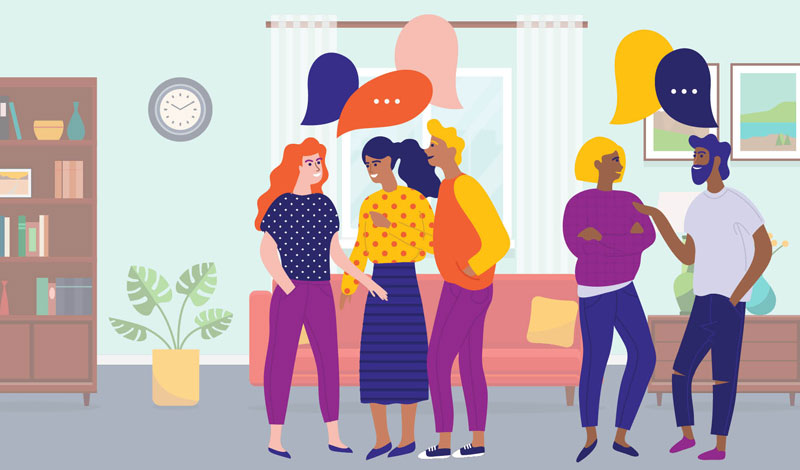This series highlights how Buddhism can enhance daily living. As Nichiren Daishonin says: “When the skies are clear, the ground is illuminated. Similarly, when one knows the Lotus Sutra, one understands the meaning of all worldly affairs.”[1]
Did you know weekly religious service participation may significantly improve your health?
Many long-term studies link regular participation in faith communities with a host of positive impacts on our health and well-being.
Harvard University’s Human Flourishing Program[2] analyzed data collected from tens of thousands of people divided into three groupings that differ in age range—the first group’s average age was 23, the second, 47, and the third, 69.
The study found that, in all three age groups, those who “attended religious services weekly or more were 16% less likely to become depressed and showed a 29% reduction in smoking and 34% reduction in heavy drinking.” It also found that regular attendance can reduce hopelessness, anxiety and loneliness, increase positive affect and life satisfaction and inspire social integration and a sense of purpose.[3]
Dr. Harold Koenig, founding co-director of Duke University’s Center for Spirituality, Theology and Health, has conducted several studies in this area and found that weekly engagement in one’s religious community can lead to significant health benefits, like lower blood pressure[4] and a healthier immune system.[5]
One notable finding: Simply identifying with one’s faith doesn’t seem to do the trick. Regular participation in that community may be the key to the associated physical, mental and emotional benefits.[6]
Our Soka Community: An Oasis Amid the Rigors of Life
Reflecting these findings, regular engagement in our Soka community garners many benefits to our well-being and sense of fulfillment. At our SGI activities, members often share how their Buddhist practice saved their lives in various ways.
As individuals, we have a structured and consistent “practice for ourselves,” rooted in our twice-daily recitations of the Lotus Sutra, chanting Nam-myoho-renge-kyo and our study of Nichiren Daishonin’s teachings.
“Practice for others,” another integral part of our daily Buddhist practice, entails chanting for loved ones, sharing Buddhism with others, supporting fellow Buddhists and participating in our local SGI activities.
The give-and-take in our Buddhist practice for self and others engenders personal growth, social connections and friendships that buoy us, especially when facing the rigors of life.
In our Soka community, we also find a safe space where we aim to welcome everyone with open ears and hearts and strive to treat each person with generosity and respect. We could say that our districts and discussion meetings are the heart of Soka, epitomizing our community’s warmth and care.
Amid today’s loneliness epidemic, global conflicts, climate change and more, we can easily succumb to negative feelings like fear, anger or despair.
Yet, week after week, month after month, we have a space where we turn our empathetic ears to hear others’ challenges and offer our own testimonies of winning over difficulties through earnest prayer and courageous action. Our discussion meetings and various other activities, like oases, allow all who attend to rejuvenate their lives and arm themselves with fresh resolve to thrive in their daily lives.
While we may not always recognize it, our consistent engagement in our Soka community not only benefits our health and well-being, but it also ripples outward to effect a change in the health and well-being of society at large.
—Prepared by the SGI-USA Study Department
December 1, 2023, World Tribune, p. 10
References
- “The Object of Devotion for Observing the Mind,” The Writings of Nichiren Daishonin, vol. 1, p. 376. ↩︎
- https://hfh.fas.harvard.edu <accessed on Nov. 15, 2023>. ↩︎
- https://www.psychologytoday.com/us/blog/human-flourishing/202102/how-religious-community-is-linked-human-flourishing <accessed on Nov. 15, 2023>. ↩︎
- https://corporate.dukehealth.org/news/religious-elderly-have-lower-blood-pressure-duke-study-shows <accessed Nov. 14, 2023>. ↩︎
- https://corporate.dukehealth.org/news/duke-study-attending-religious-service-may-improve-immune-status <accessed on Nov. 15, 2023>. ↩︎
- In his paper “Religious Communities and Human Flourishing,” Harvard epidemiology professor Tyler VanderWeele says: “Religious identity and private spiritual practices may of course still be important and meaningful within the context of religious life, but they do not appear to affect health and well-being as strongly. The communal element seems essential.” See https://www.ncbi.nlm.nih.gov/pmc/articles/PMC5665144/ <accessed on Nov. 16, 2023>. ↩︎
You are reading {{ meterCount }} of {{ meterMax }} free premium articles

